Piaget Altiplano Ultimate Concept, The World’s Thinnest Watch: Shaving Microns To Make Millionths
Have you already picked the winner of the next Kezuroukai planing competition and are wondering if the record will be broken with an official full-width, full-length measurement of less than two microns? It’s hard to say as the best in the world are all racing toward zero – or at least hoping to get less than one – but who knows if that is even possible.
Wait, you’ve never heard of the Kezuroukai planing competition? Kezurou-kai is a group of thousands of Japanese (and some international) woodworkers who specialize in using hand planes to create very, very thin shavings from very straight pieces of wood that border on insanity. The name translates to “shaving group,” and it couldn’t be more on point.
Combining centuries’ worth of traditional skills and know how and years of patient, careful practice and mastery of the craft, people come together in competition to see who can shave the most consistent and thinnest ribbon of wood out of expertly prepared beams. Ranging in width from just a few centimeters to more than 30 centimeters, the planes are all custom made and meticulously sharpened by hand before being delicately adjusted to shave the bare minimum from the wood.
The average competitors’ shavings fall somewhere in the range of 15 to 7 microns of thickness, which is equivalent to one-tenth the thickness of a human hair. But the standouts in their field commonly achieve thicknesses less than five microns, and reports of an unofficial record is around two microns – or the thickness of a red blood cell.
This is mighty impressive, especially when you consider the difference in thickness between the winners and losers is smaller than the level of tolerance on many precision-machined components. Unless we are talking about watches.
Thinness is always one point of awe when it comes to micromechanics, and whenever I hear about mind bogglingly thin things such as world-record shavings from the Kezuroukai planing competition, it reminds me just how hard it is to make anything thin. Especially something that needs to fulfill a mechanical function.
And exceptionally thin mechanics leads us to world-record-holding thin watches, which inevitably leads to Piaget. These days constantly in battle with Bulgari for thinness world records, Piaget has recently released the production version of the Altiplano Ultimate Concept, which now holds the record for mechanical watch thinness at just 2 mm, which may be incredibly difficult to better.
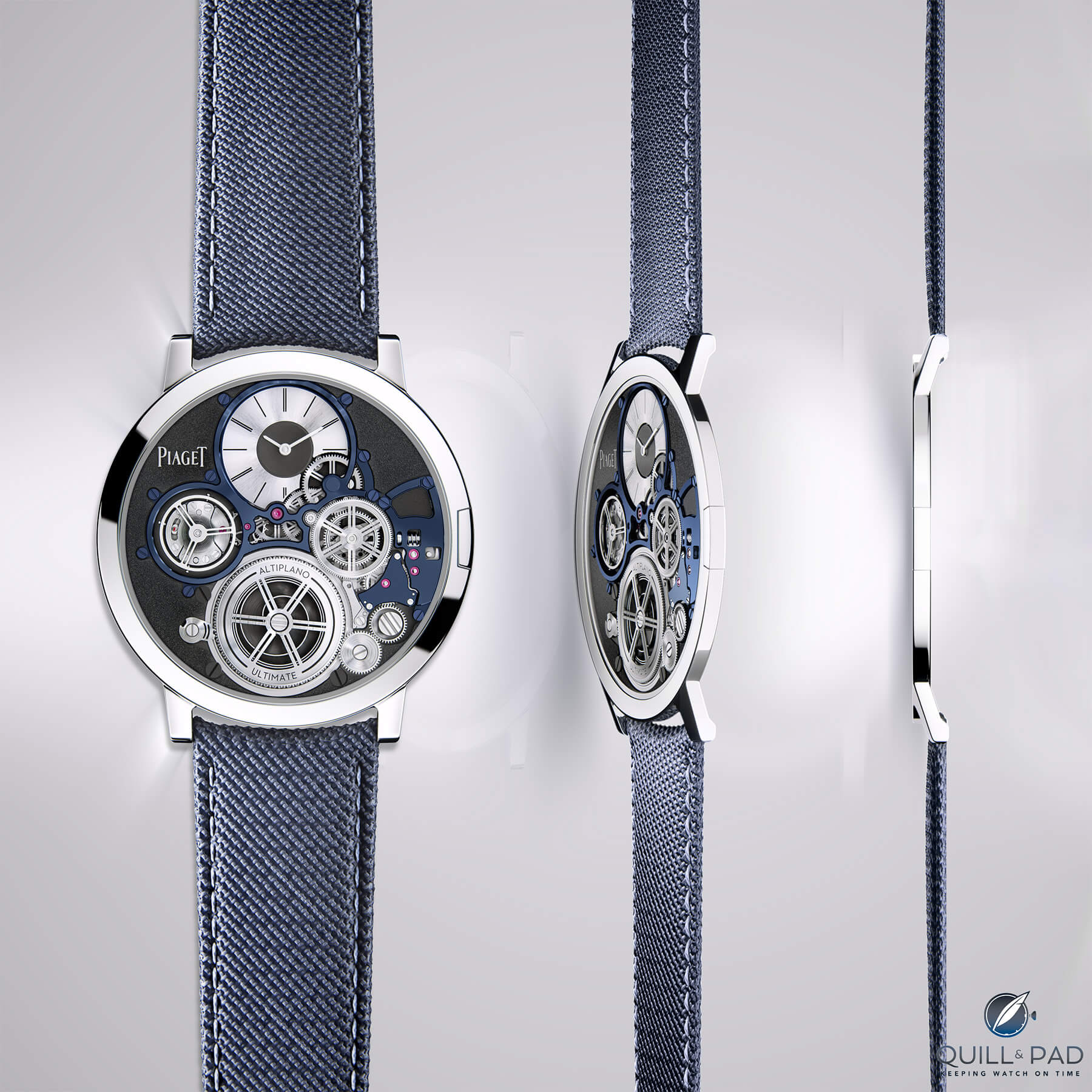
Piaget Altiplano Ultimate Concept
Piaget Altiplano Ultimate Concept
When it first debuted back in 2018, the Altiplano Ultimate Concept was groundbreaking. Yet, as a one-off proof of concept it remained uncertain as to whether it could be developed into a production watch. At that year’s SIHH, Piaget was even hesitant to let anyone handle it, so I reined in my excitement for the brand’s signal that it is ready for the consumer. And that day is today.
Overall, the Altiplano Ultimate Concept hasn’t visually changed much from the original concept piece, with only a few minor adjustments to bridge over the winding mechanism, some structure under the going train by the dial, and some variation in the mainspring ratchet wheel. Any other adjustments are likely optimization of the mechanism itself.
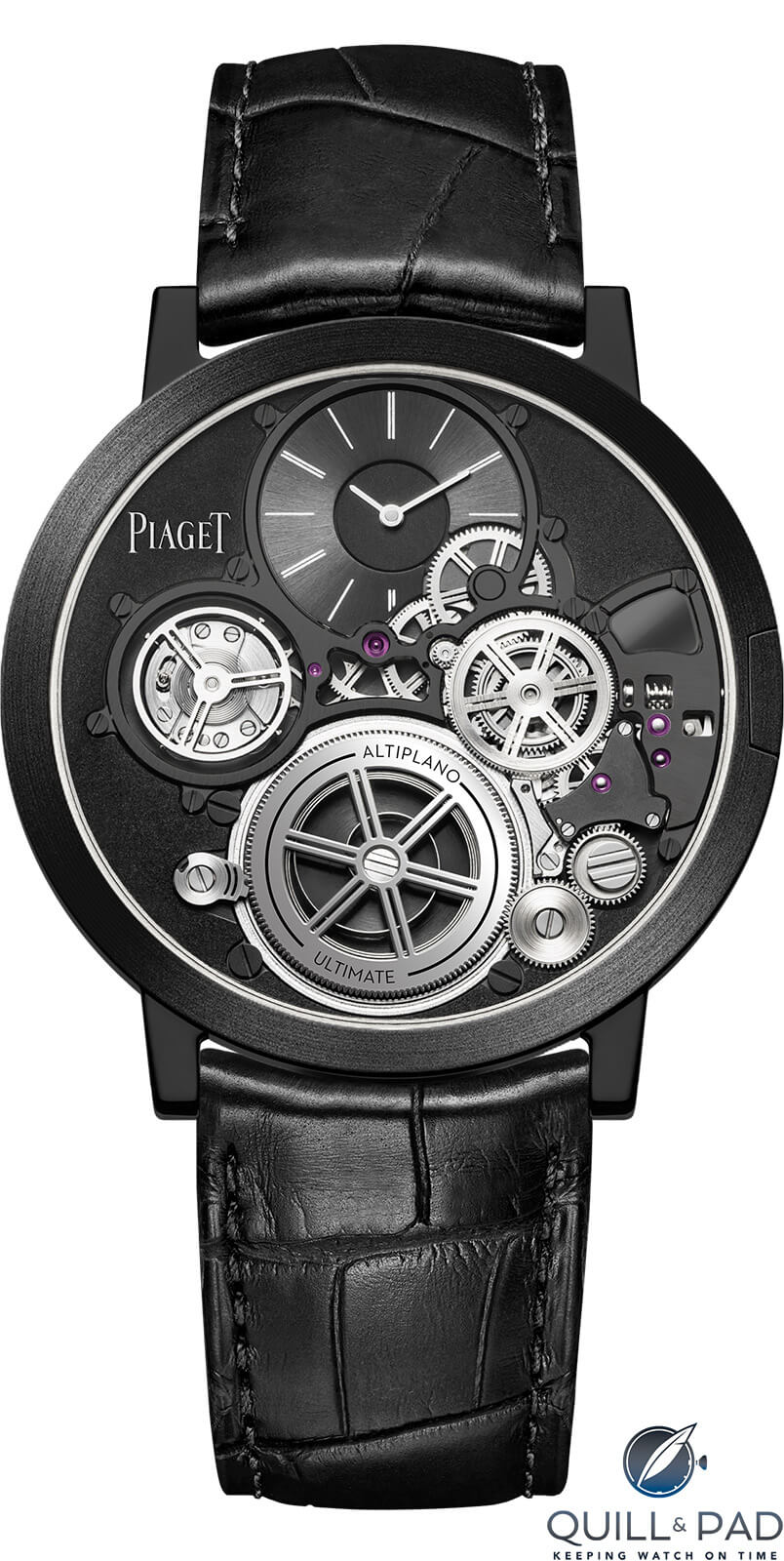
Piaget Altiplano Ultimate Concept
It is great to see that what made it so incredible when it first came out hasn’t disappeared; Piaget spent the last two years testing, tweaking, and proving that it could be a true, usable piece able to live up to real-world scenarios. Normally this would be be a formality for a basic time-only movement, but when you reinvent the wheel a dozen times all at once, it requires a bit more scrutiny to vet the creation.
What is the Piaget Altiplano Ultimate Concept exactly?
And why did it take so long to make sure it was suitable for the public? That’s the fun part.
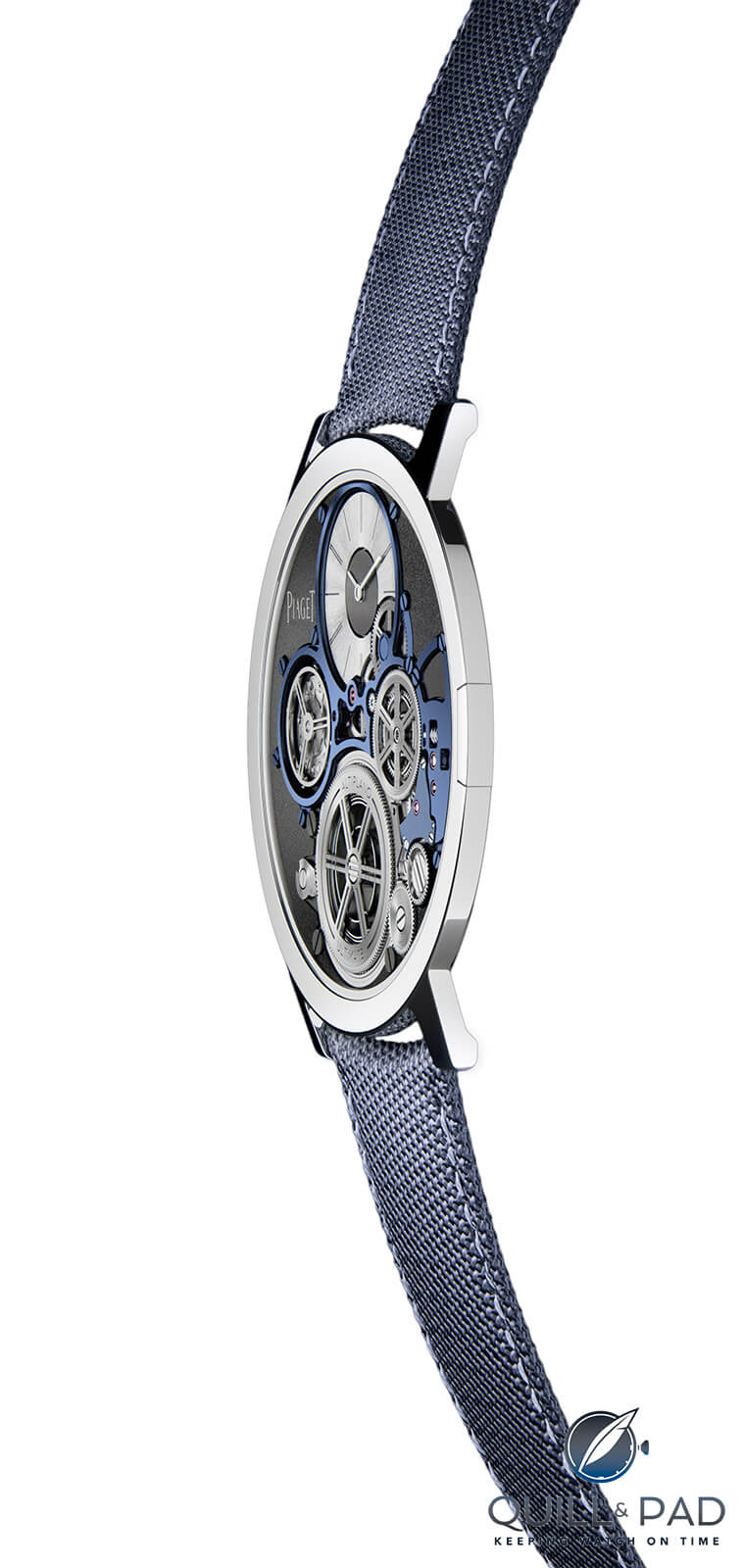
Piaget Altiplano Ultimate Concept from the barely-there side
The Altiplano Ultimate Concept is the thinnest hand-wound mechanical watch in the world. To achieve this feat required changing almost everything about how a typical watch movement is constructed.
It began with rethinking how to construct a thin movement, starting with the base plate. This is usually the thickest part of a movement as it supports the entire assembly, so it needs to be strong and precise. Piaget realized that putting a movement into a case meant that there were just too many layers of material to keep making everything thinner. Something had to give.
The idea was to eliminate the difference between the case and the movement: the monoblock was born. Well, born again.
The idea was first used by ETA and debuted in the Concord Delirium in 1979 as a quartz watch (which also later inspired Swatch watch construction) and ensuingly by Audemars Piguet in the 1980s.
After merging case and caliber in the Altiplano 900P in 2014 (then the thinnest hand-wound watch in the world), Piaget debuted a new monoblock watch design in 2017 with the Altiplano Ultimate 910P, which became the thinnest automatic watch for a short time before Bulgari stole the crown back with its Octo Finissimo.
Then in 2018 Piaget pushed things further when it debuted the original Altiplano Ultimate Concept; the third iteration of the monoblock left many with their jaws on the floor.
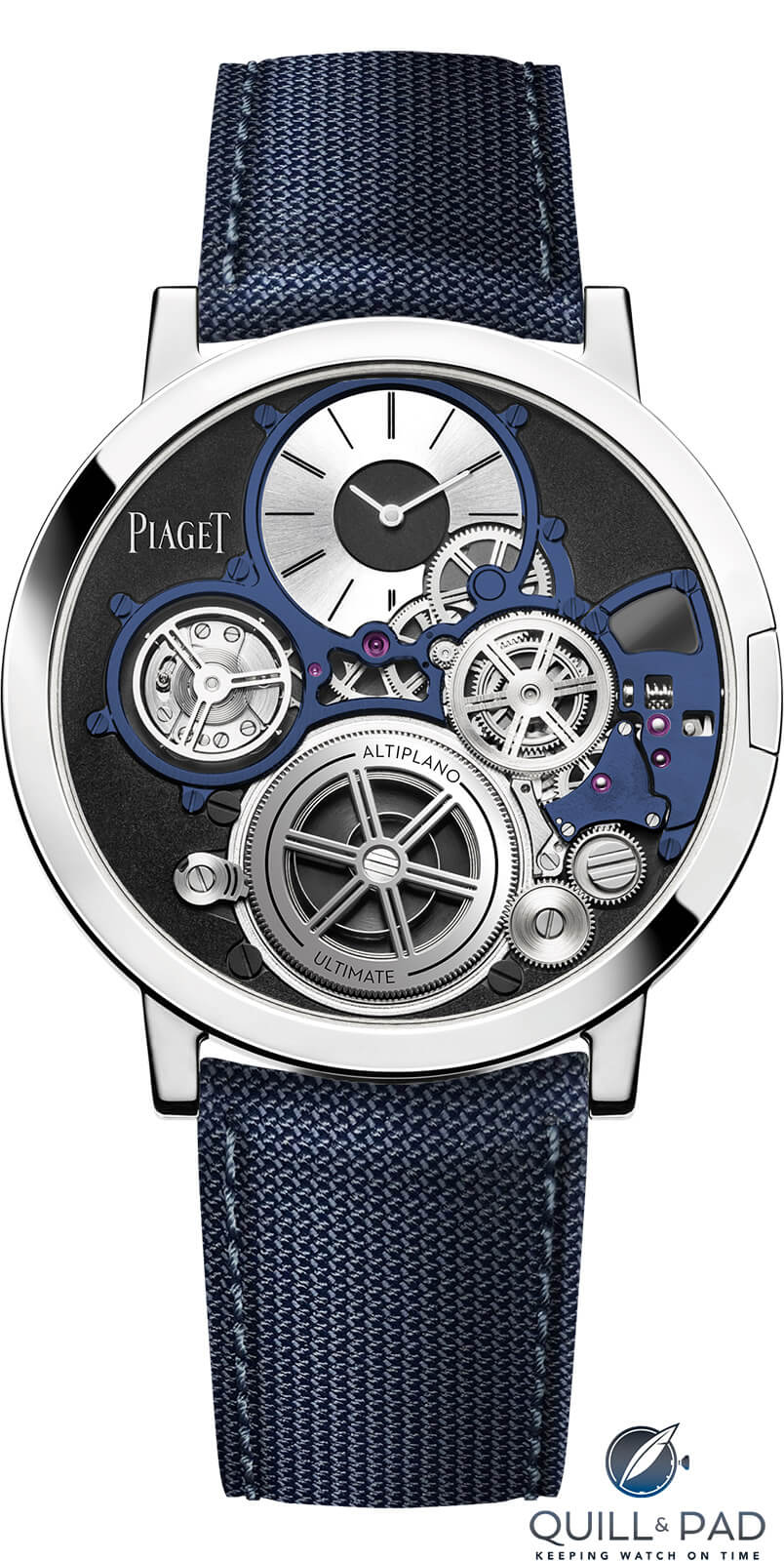
Piaget Altiplano Ultimate Concept
The entire case is the base plate that supports all of the winding mechanism, going train, balance assembly, everything; all of the components in the movement are attached directly to the monoblock case. This allows a lot of thickness to be eliminated, and at its thinnest point means that the wearer’s wrist is only 0.12 mm away from the closest moving part within the movement, the mainspring. The case, made from a cobalt alloy, has no separate bezel or other feature that isn’t absolutely necessary.
That’s not all, folks
If this construction method was the only trick employed, this would still be a remarkable watch, but it is far from the only factor. The balance assembly has no supporting balance cock or bridge and oscillates around a center stud, dramatically reducing the required thickness of the movement. It appears almost like a flying tourbillon only it is far cooler in this configuration.
I can imagine that this may have been one of the areas closely scrutinized over the previous couple years and optimized to ensure longevity of the mechanism.
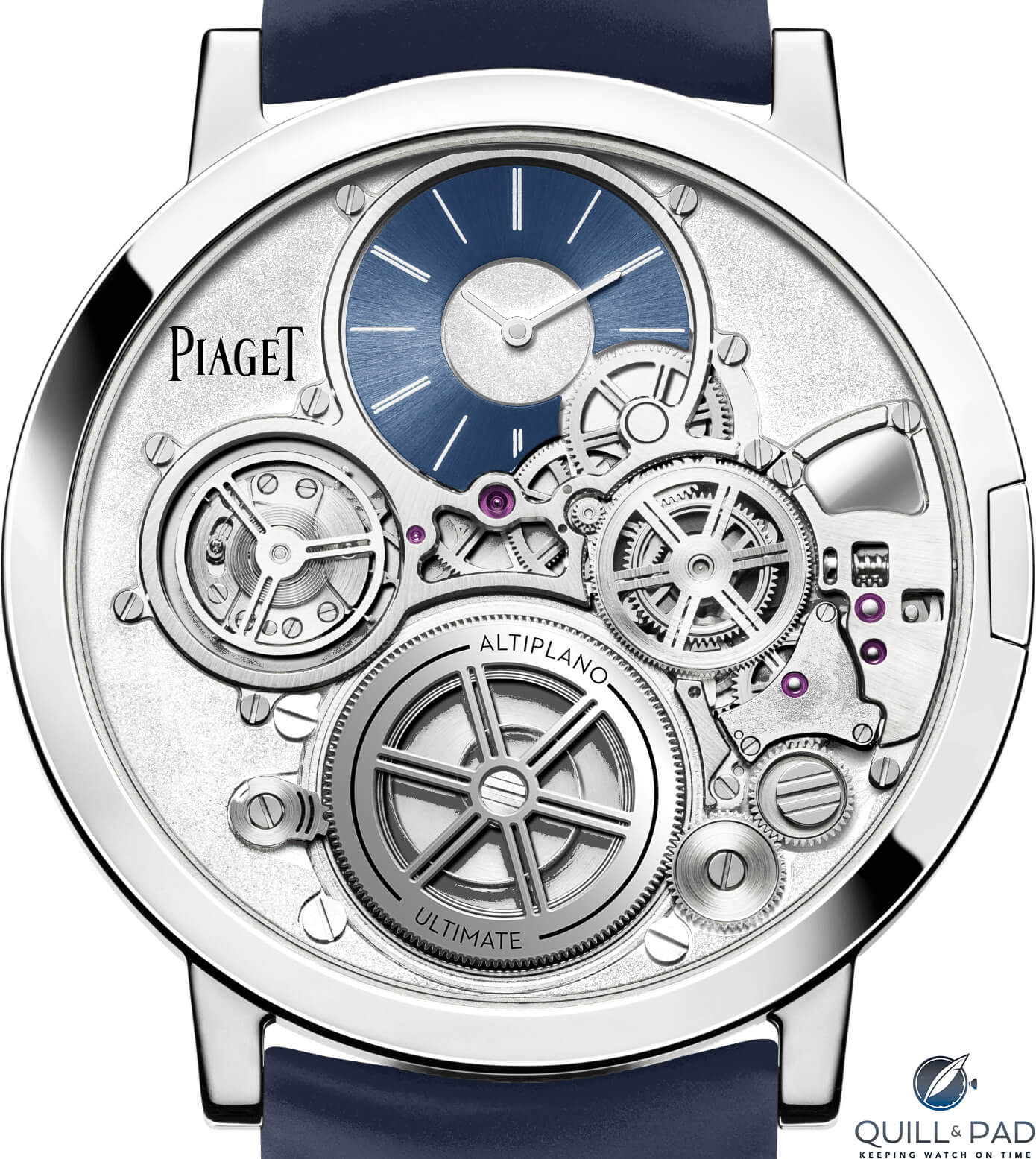
Piaget Altiplano Ultimate Concept
At the bottom we find the mainspring, which is missing a lot of what you would normally find there. There is no actual barrel or barrel cover: the ratchet wheel acts as the cover, and a ring around the mainspring delivers power to the going train.
The mainspring itself is connected to a single ceramic ball bearing on a central post, which allows for smooth, low-friction power delivery and does the job with less parts than traditional mainsprings, keeping it low profile. Interestingly, the ratchet click is higher than the mainspring, which I believe plays an important role and I’ll touch on a bit later.
Directly above the area bearing the mainspring we find the going train snaking between it and the dial, maintaining space to fit under the already sunken dial. The hour hand is a disk with the hand applied to lower the necessary height of the minute hand, likely shaving off precious microns.
This type of thinking, pushing each component to get a bit shorter and a bit thinner, is found on nearly every part. All of the wheels shrank in thickness by almost half to 0.12 mm, or slightly thicker than a sheet of printer paper. Gears that are paper thin, now that’s commitment.
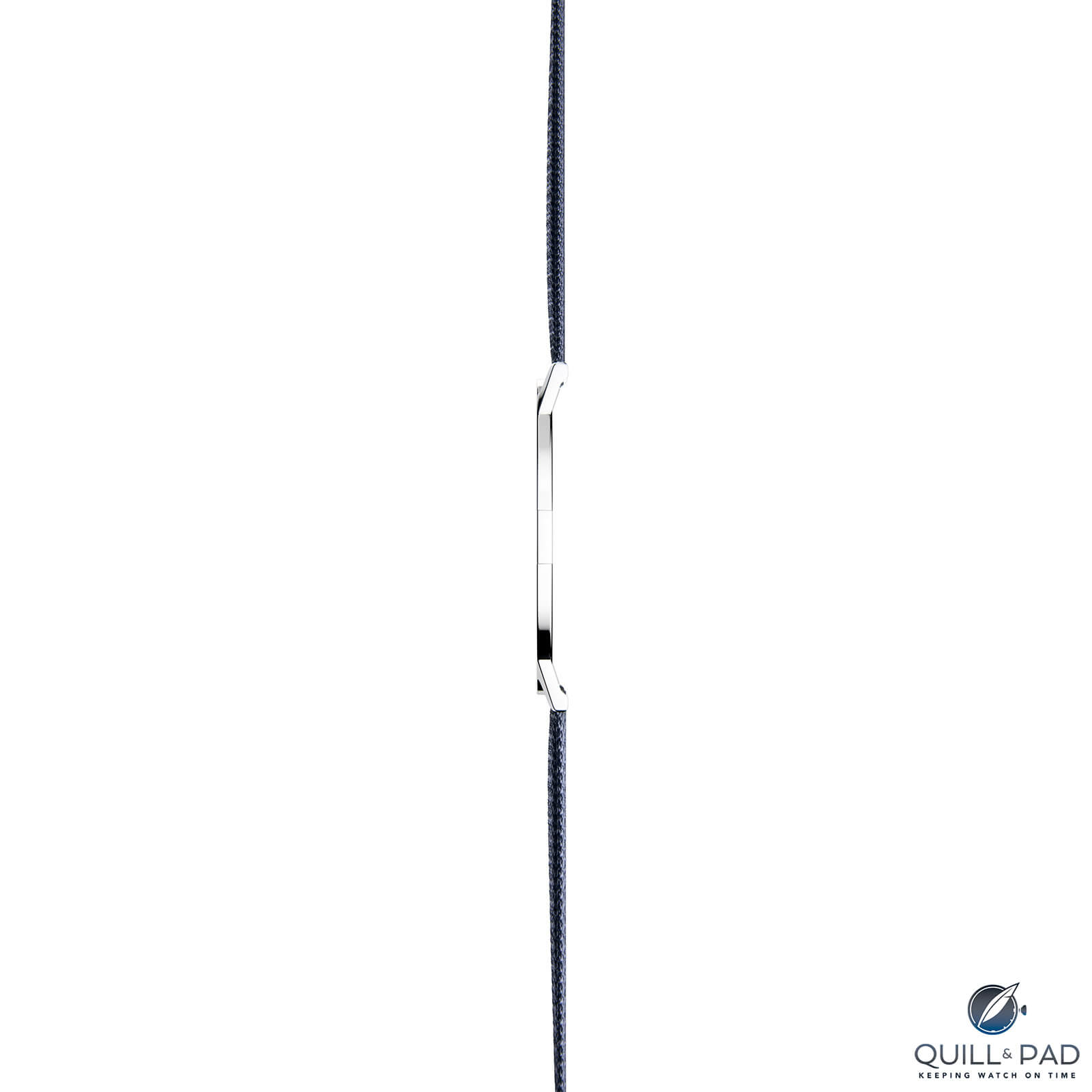
Thin enough? Piaget Altiplano Ultimate Concept
The sapphire crystal is dramatically thinner than the average of one millimeter, measuring here only 0.2 mm or the exact thickness of two pieces of printer paper. I just measured this to confirm and had to gasp as it seems so thin.
And this is where we come back to my point earlier about the ratchet click sitting higher than many of the parts around it. The layout of the movement was strategically designed to also support the very thin sapphire crystal by using high points, most likely the screws holding bridges down or the bridges themselves, to provide a bit of a backing for when the crystal flexes from a light impact. I don’t think it will survive any reasonably firm knock against a door handle, but like a smartphone screen it is probably resilient to regular bumps.
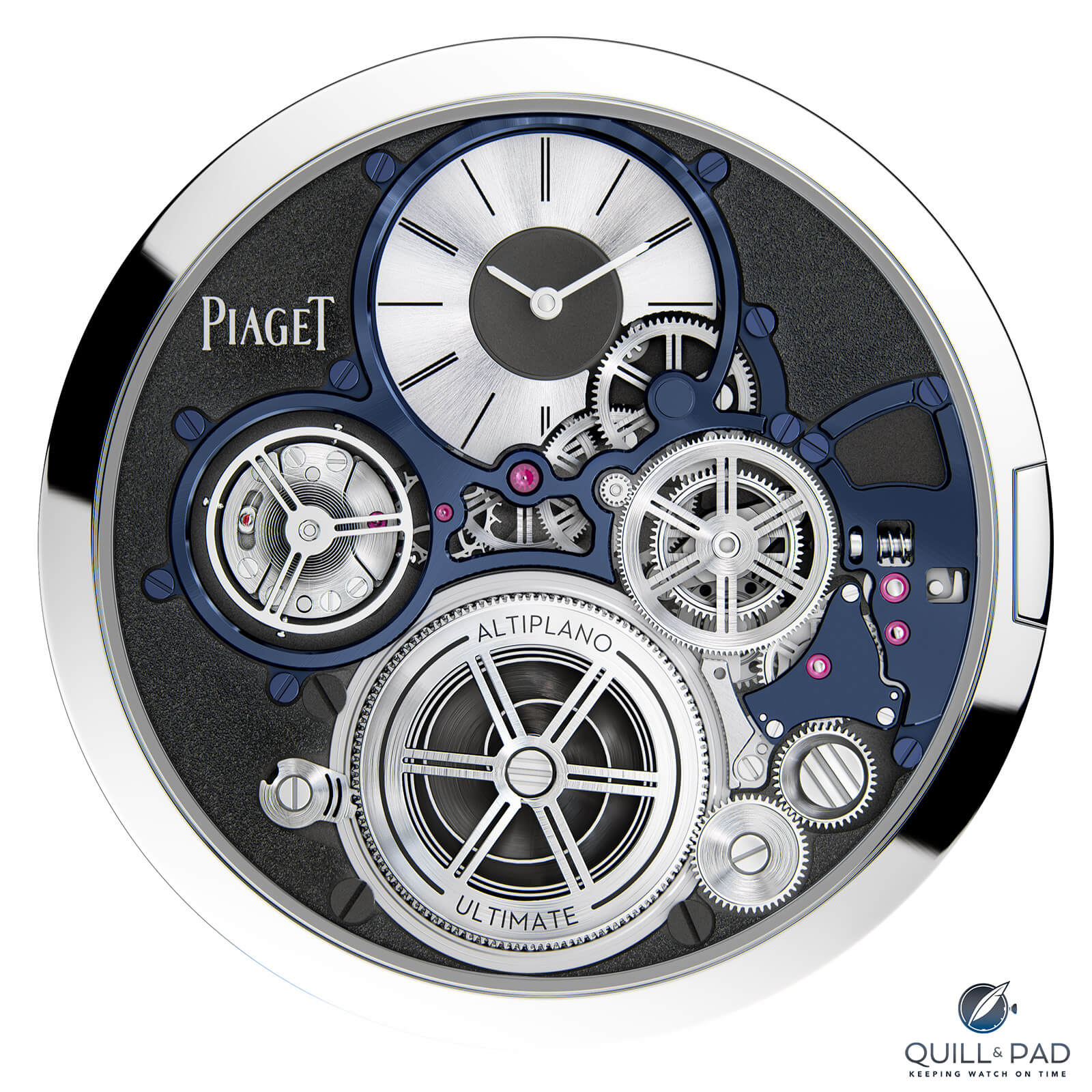
Piaget Altiplano Ultimate Concept
For a watch this thin, there are just so many aspects to consider. The typical winding mechanism was swapped for a worm screw, which basically creates a rotation at 90 degrees to the axis of the stem, all within the average diameter of that stem with no bevel gears required. It’s a mechanically simple addition but crucial in this context.
That attention finally extends to the crown, which is a rectangle fit neatly into a slot in the side of the case, thus avoiding any bulge from a typically much larger round crown. Given the round crown even on the incredibly thin Altiplano Ultimate 910P, it shows how much more in tune the watchmakers and engineers were with the goal.
That goal was to make the thinnest mechanical watch in the world.
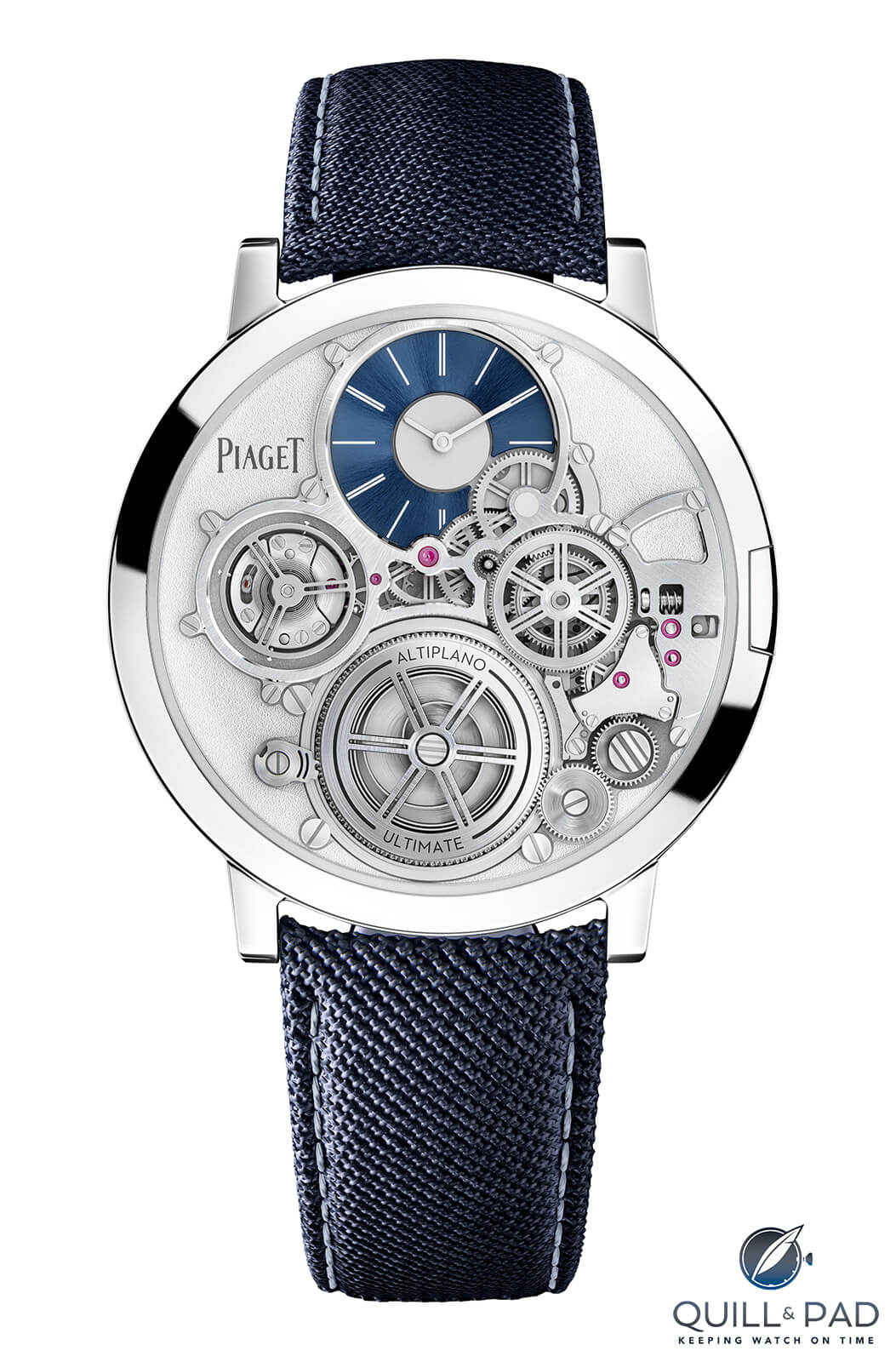
Piaget Altiplano Ultimate Concept
I was hesitant a couple years ago that it may have been a one-off, but seeing that it is now released as a part of the collection (though still only special order), I am certain this watch will join the greats and be heralded as bordering on impossible – or at least so difficult to beat that the record just may stand for a little while. For Piaget’s sake, I hope it lasts!
And lasts, and lasts, and lasts until I break it down!
- Wowza Factor * 10 It’s hard to give this anything less than a perfect score. Not only is it a record setter, it bucked nearly every tradition in the process!
- Late Night Lust Appeal * 100» 980.665m/s2 There is some strong lust for a watch so thin you can’t even tell it’s on your wrist but complex enough to have spawned five new patents!
- M.G.R. * 72 This one gets a perfect score simply due to how incredibly unlikely the chances were that this movement could be turned into a production piece, and yet here we are!
- Added-Functionitis * N/A And who cares that it only tells the time, the entire watch is only two millimeters thick! You can skip the Gotta-HAVE-That cream and just enjoy the majesty of micromechanical engineering!
- Ouch Outline * 11.5 Accidentally hitting your hand with a hammer while trying to secure a part in place! This one doesn’t get a perfect score because no matter how much I love this watch, I also know that I am very hard on watches, and so I legitimately fear destroying a watch like this the very first day I would own it. But I’d still gladly take one for the team if it meant getting one on my wrist!
- Mermaid Moment * Exactly how thick are we talking?! Incredulity is almost the natural first response, and it also marks the moment where you understand you won’t be thinking about anything else for quite a while.
- Awesome Total * 989 First take the caliber number (900) and add the number of hours in the power reserve (48), and finally add the diameter of that ultra-thin case (41) for a perfectly proportioned awesome total!
For more information, please visit piaget.com/watches/cobalt-ultra-thin-mechanical-watch.
Quick Facts Piaget Altiplano Ultimate Concept
Case: 41 x 2 mm, cobalt alloy, sapphire crystal 0.2 mm in height, flat telescopic crown
Movement: ultra-thin manual-wind Caliber 900P-UC, 28,800 vph/4 Hz frequency, 40-hour power reserve
Functions: hours, minutes
Limitation: 3 per year, by special order only, only available through Piaget boutiques
Price: on request
You may also enjoy:
Piaget Meteorite Altiplano Watches: Ultra Slim, Ultra Tasty, And Out Of This World
Piaget Upstream: Why I Chose The Underdog
60 Years Of Piaget Altiplano: Sophisticated Style Versus Fugitive Fashion
Leave a Reply
Want to join the discussion?Feel free to contribute!



wow. And so great to read about the ultra thin Piaget here in your article, dear Joshua. Thank you. This is such an impressing watch. It is not only the thinnest, it is also very beautiful, and it is technically fascinating. Waiting to see it in real, anytime, anywhere. Regards, Thomas